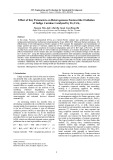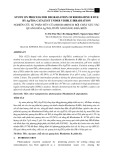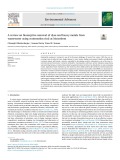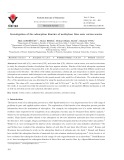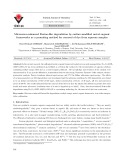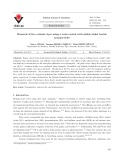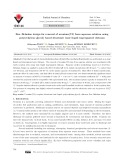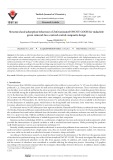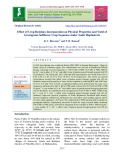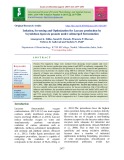
Effect of initial pH
-
In this paper, we discuss the efficiency of using a Fe2V4O13 catalyst in a heterogeneous Fenton-like process for the degradation and mineralization of Ind. We examined various factors that influence the reaction, such as the initial pH of the reaction mixture, the initial concentration of hydrogen peroxide, the amount of the Fe2V4O13 catalyst, and the reaction temperature was investigated.
 9p
9p  vijeff
vijeff
 30-11-2023
30-11-2023
 5
5
 2
2
 Download
Download
-
In the present investigation, to explore the possibility of Ag/TiO2 for photocatalytic degradation of RB dye in visible light has been carried out. The effects of various parameters such as catalyst amount, initial dye concentration, pH have been investigated on the photocatalytic degradation of RB in the presence Ag/TiO2 as a photocatalyst under irradiation of visible light.
 7p
7p  vidoctorstrange
vidoctorstrange
 06-05-2023
06-05-2023
 4
4
 2
2
 Download
Download
-
In this study, the noncompetitive and competitive adsorption process of copper (II) and nickel (II) ions on the natural zeolite were examined in simulated wastewater in a batch system with respect to concentration, pH and temperature. Optimum pH values were found as 5,0 for adsorption of copper and nickel ions on the zeolite. The effect of initial concentration and ambient temperature on the yield of adsorption was examined at this pH value.
 13p
13p  lyhuyenthu
lyhuyenthu
 31-01-2023
31-01-2023
 4
4
 3
3
 Download
Download
-
The conversion of fumaric acid into L-malate by fumarase immobilized on silanized nanostructures was analyzed experimentally. The enzyme was bound to the silanized nanostructures. We carried out scanning electron microscopy (SEM), fourier transform infrared spectroscopy (FTIR) analysis, zeta size analysis and surface area calculation for the characterization of the nanostructures. The effect of initial enzyme concentration and pH on immobilization procedure were investigated and the change of Michaelis-Menten constants (Km and Vmax) with immobilization was examined.
 8p
8p  lyhuyenthu
lyhuyenthu
 31-01-2023
31-01-2023
 5
5
 1
1
 Download
Download
-
In this study, the performance of chitosan based semi-IPN nanocomposite hydrogels for the adsorptive removal of basic violet 14 (BV14) from aqueous solution has been explored. Batch adsorption studies were conducted to determine the effect of various parameters on BV14 adsorption, and optimum values were reported as pH of 8, the adsorbent dosage of 0.025 g, initial BV14 concentration of 5 mg L–1 and contact time of 90 min at a temperature of 25 °C.
 15p
15p  lyhuyenthu
lyhuyenthu
 31-01-2023
31-01-2023
 7
7
 1
1
 Download
Download
-
This paper reviews the various important aspects of utilization of watermelon rind as a biosorbent for removing dyes and heavy metals from contaminated water. The effects of several factors such as pH, initial solute concentration, biosorbent dose, co-solute concentration, activation etc. has been reviewed in this paper.
 13p
13p  thebadguys
thebadguys
 15-01-2022
15-01-2022
 10
10
 0
0
 Download
Download
-
Cotton stalk (CS), cotton waste (CW), and cotton dust (CD), which are cotton wastes, were used as adsorbents to study the adsorption kinetics of methylene blue from aqueous solution. Kinetics of the batch adsorption experiment was investigated according to the pseudo-first order, the pseudo-second order, and the intraparticle diffusion models used commonly in the literature. The effects of the initial concentration, solution pH, and temperature on kinetic parameters (adsorption rate constant, initial adsorption rate, equilibrium adsorption capacity, etc.) were studied.
 16p
16p  langthannam
langthannam
 29-12-2021
29-12-2021
 10
10
 0
0
 Download
Download
-
A magnetic Fe3O4 @ montmorillonite composite was prepared and used for the separation of lead and cadmium from aqueous solutions. For this purpose, magnetite (Fe3O4) was generated by co-precipitation of FeSO4 and FeCl3 onto montmorillonite. The effects of various experimental parameters such as pH of the solution, amount of sorbent, initial concentration of analytes, and contact time on the sorption efficiencies of lead and cadmium ions were investigated and optimized by applying a batch technique.
 5p
5p  langthannam
langthannam
 29-12-2021
29-12-2021
 12
12
 0
0
 Download
Download
-
Tetra–n-butylammonium bromide modified sugar beet pulp (TBAB–SBP) with good biosorption and regeneration potential was prepared for removal of dye from contaminated solutions. The decolorization performance of TBAB–SBP was investigated using Reactive Yellow 2 (RY2) as a model dye. The characterization of the modified biosorbent was investigated by IR, SEM, zeta potential, and BET surface area analysis to discuss the decolorization mechanism. The effects of initial pH, biosorbent amount, contact time, dye concentration, and flow rate on the treatment process were examined.
 11p
11p  langthannam
langthannam
 29-12-2021
29-12-2021
 4
4
 0
0
 Download
Download
-
In the current research, the sulfonated metal–organic framework loaded on iron oxide nanoparticles, Fe3O4@MIL100(Fe)-OSO3H, has been synthesized and utilized as a Fenton-like catalyst for the decolorization of aqueous solutions containing methyl orange (MO) dye as a model organic pollutant. The morphology and structure of the catalyst were characterized by X-ray powder diffraction, transmission electron microscopy, Brunauer–Emmett–Teller analysis, thermogravimetric analysis, Fourier transform infrared spectroscopy, and UV-Vis diffuse reflectance spectroscopy.
 14p
14p  langthannam
langthannam
 29-12-2021
29-12-2021
 19
19
 0
0
 Download
Download
-
Resins coated with nickel/nickel boride nanoparticles were used to remove brilliant green, methyl violet, methylene blue, phenosafranine, and brilliant cresyl blue from water. The effects of pH, adsorbent dose, contact time, and initial dye concentration on the adsorption efficiencies were investigated. The point of zero charge for the adsorbent was pH 9.5. Isotherm studies were conducted using Langmuir, Freundlich, and Dubinin–Radushkevich models, and thermodynamic studies were also performed. Adsorption of the five dyes was found to obey the Langmuir isotherm model and was endothermic.
 15p
15p  tudichquannguyet
tudichquannguyet
 29-11-2021
29-11-2021
 25
25
 1
1
 Download
Download
-
Poly(ethylene glycol) bis(methylimidazolium) di[bis(trifluoromethylsulfonyl)imide] was synthesized as an ionic liquid and impregnated onto chitosan. The removal of uranium(VI) ions from aqueous solution was investigated with batch sorption tests using ionic liquid impregnated chitosan. Response surface methodology based on 3 level Box– Behnken design was applied to analyze the effect of initial pH (4–6), initial concentration (20–60 mg L −1 ), contact time (15–105 min), and temperature (30–50°C) on the uptake capacity of uranium(VI).
 19p
19p  tudichquannguyet
tudichquannguyet
 29-11-2021
29-11-2021
 14
14
 1
1
 Download
Download
-
Amorphous cerium phosphate was prepared and characterized. Three-level Box-Behnken design (BBD) was employed to analyze the effect of process variables such as initial pH (2–6), contact time (60–180 min), and sorbent amount (0.05–0.15 g) on the sorption capacity of europium. Analysis of variance (ANOVA) revealed that the main effect of initial pH and sorbent amount has a substantial impact on the sorption of Eu(III). Probability F-value (F = 3 × 10 −3 ) and correlation coefficient (R2 = 0.97) point out that the model is in good accordance with experimental data.
 16p
16p  tudichquannguyet
tudichquannguyet
 29-11-2021
29-11-2021
 12
12
 1
1
 Download
Download
-
This study aimed to propose a mathematical method to investigate and optimize the simultaneous elimination process of multiple organic pollutants using the Fenton process. Hence, the treatment of rhodamine B (RB) and acid red 14 (AR14) dyes in their binary solution was studied. Multivariate curve resolution alternating least square (MCR-ALS), a novel chemometric method, was applied along with correlation constraints to resolute the UV-Vis spectrophotometric data, enabling quantification of investigated dyes despite a high spectral overlapping.
 15p
15p  tudichquannguyet
tudichquannguyet
 29-11-2021
29-11-2021
 10
10
 1
1
 Download
Download
-
In this study, an effective adsorbent was synthesized to remove malachite green (MG), which is one of the toxic dyes. Firstly, single walled carbon nanotube with carboxylated acid (SWCNT-COOH) was functionalized with diethylenetriamine and a new nanocomposite was obtained using nano zinc oxide (ZnO) powder. The effects of pH (3–7), the amount of adsorbent (5–15 mg) and the initial concentration (10–50 mg L–1) of the solution on the adsorption uptake were investigated. The optimal parameters that maximize the adsorption uptake according to the specified working range are found to be 4.
 13p
13p  tudichquannguyet
tudichquannguyet
 29-11-2021
29-11-2021
 12
12
 0
0
 Download
Download
-
Hydrotalcite has been considered as a promised adsorbent to remove arsenic. In this study, bench scale studies were conducted to evaluate the effects of adsorbent dose and initial pH on the efficiency for removing arsenic (As)(III) and As(V) by adsorption onto an Al-based hydrotalcite (named MA3). Then the maximum removal adsorption capacity and isothermal models were investigated. The results showed that the optimum pH values for removing As(III) and As(V) were 10 and 5-6, respectively.
 6p
6p  cothumenhmong11
cothumenhmong11
 10-05-2021
10-05-2021
 9
9
 2
2
 Download
Download
-
In this study, batch and continuous-flow sorption experiments were conducted to evaluate the removal of methylene blue (MB) from aqueous solutions by Carica papaya wood (CPW) biosorbents. The effects of critical factors such as initial pH, particle size of the biosorbent, biosorbent dosage, initial dye concentration, contact time, and salt ionic strength were studied in batch experiments.
 10p
10p  nguaconbaynhay10
nguaconbaynhay10
 29-01-2021
29-01-2021
 13
13
 1
1
 Download
Download
-
A field investigation was conducted during 2004-2005 at Karanja Ramzanpur, village in Purna valley in Vidarbha region. The experimental was laid out in Randomized Block Design, consisting of seven treatments i.e. 100 % RD of NPK, 50 % RD of NPK, PSB 10 kg ha-1 , crop residue @ 2 t ha-1 and alkali water irrigation passed through gypsum bed (30 cm thickness). The initial pHs, ECe, SAR and ESP representative soil varied from 8.51 to 8.40, 1.06 to 1.18, 15.17 to 9.22, 18.36 to 12.19 respectively.
 14p
14p  caygaocaolon8
caygaocaolon8
 07-11-2020
07-11-2020
 17
17
 2
2
 Download
Download
-
In this study, a continuous ammonium stripping lab-scale model of anaerobic co-digestion effluent from an organic fraction of food waste and domestic wastewater was used to investigate ammonium removal efficiency by air stripping. The effect of initial pH, liquid flow rate, and air-to-liquid ratio on the removal of ammonium from the effluent were examined in experiments.
 5p
5p  kethamoi7
kethamoi7
 15-08-2020
15-08-2020
 16
16
 1
1
 Download
Download
-
Twenty Five lignolytic fungi were isolated from decaying wood samples and were screened for the laccase production using guaiacol and ABTS as indicator compounds. The positive isolates were confirmed for the presence of laccase using Azure B and quantitative enzyme assay in presence of catalase using ABTS as substrate. Further laccase producing capacity of fungus was estimated in seven different media where Czapex Dox medium showed highest enzymatic activity of 17.2 U/ml.
 15p
15p  angicungduoc6
angicungduoc6
 20-07-2020
20-07-2020
 15
15
 1
1
 Download
Download
CHỦ ĐỀ BẠN MUỐN TÌM









